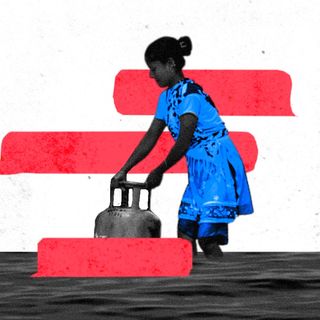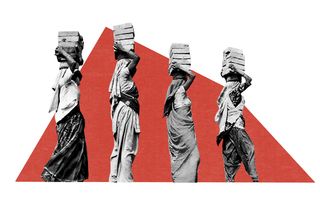
More Than 50 Million People Globally Are Now Trapped in Modern Slavery: ILO Report
Women in forced labor face wage non-payment and threat of dismissal, reflecting a “surge of exploitation” over the last five years.

“Forced me to clean or else she will kill me.“
“I had to leave the situation or be killed. I know I can never return home because I am considered a dead person for breaking the culture and bringing shame to the families. According to my father,
I am dead.“
The first account voices the experience of a 25-year-old migrant worker, who was subjected to coercion and threat by her employers while working in a garment factory. The second comes from a female survivor who escaped three forced child marriages. Both narratives are forms of modern slavery that continue to persist centuries after slavery was legally abolished across the world. But there remains a form of slavery that was never codified in law that continues to persist: Now, a survey shows that the number of people vulnerable to modern slavery has increased by almost 25% over the last five years itself.
These are the findings of a new report by the International Labor Organization, which outlines how modern slavery spares no region, gender, or socioeconomic background. The rise is, in part, due to the Covid19 pandemic and the situations of confinement and economic deprivation it engineered globally. On any given day, as many as 50 million people globally are trapped, abused, and subjected to inhumane conditions. While there is no legal definition afforded to the practice, modern slavery “refers to situations of exploitation that a person cannot refuse or leave because of threats, violence, coercion, deception, and/or abuse of power.” It included both forced labor (which can be imposed both in the private sector and by the state) and forced marriages.
“The scourge of modern slavery has by no means been relegated to history,” the new report noted. The prevalence of modern slavery in India echoes a part of this number: on any given day in 2016, nearly eight million people were living in modern slavery, according to Global Slavery Index estimates.
The number of people at the mercy of forced marriage, debt bondage, slavery, slavery-like practices, and human trafficking was found to be highest in Asia, with as many as 2,93,49,000 people stuck in modern slavery. This amounts to almost 6.8 persons in every 1,000 persons living in vicious conditions.
We already know forced marriage and child marriage are astonishingly common, and have only increased during the pandemic. More than six million more women and girls have reportedlybeen pushed into it since 2016. “Shuttered schools, isolation from friends and support networks, and rising poverty have added fuel to a fire the world was already struggling to put out,” UNICEF Executive Director Henrietta Fore said last year.
The report found that 86% of cases of forced labor were documented in private sector industries like carpet weaving, textile and garment manufacturing, manual scavenging, brick kilns, construction, agriculture, and domestic work, along with commercial sexual exploitation. Here, the main form of coercion came in the form of employers deliberately withholding wages and abusing their power by threatening to dismiss the worker. The rest comes from state-sanctioned exploitation, in the form of abuse of prison labor (for instance, imposing compulsory work on people convicted of non-political crimes or as a way to discriminate against racial or religious groups, such as the grave human rights violations against Uyghur Muslims in China) or through conscription in the military. As such, the report forces us to consider institutionalized forms of slavery that exist in plain sight — such as the use of prison labor and compulsory army enlistment.
Related on The Swaddle:
Reports Warn of Rise In Child Labor in India Due to Pandemic Economic Crisis
Two things stand out in the report. One is the stark rise in the numbers over the last five years, which can be attributed to the pandemic.“Covid19 has exacerbated the underlying drivers of all forms of modern slavery, including forced marriage, which often is linked to economic hardship,” the report noted. This is because the socio-economic turmoil led to “increased global unemployment, increased indebtedness, and an increase in extreme global poverty for the first time in two decades.”
Earlier this year, Indian activists expressed concerns about rising human trafficking in India, with Assam recording the most number of cases. School closures, lack of government infrastructure to support education, and unemployed remained the primary reasons. “People from within communities are trafficking children, women, and youths in the name of jobs as laborers outside. Those trafficked would only get to know what will happen to them only after they reach their destinations,” said Digambar Narzary, chairperson of Kokrajhar-based Nedan Foundation, an anti-trafficking NGO. Girls and women were also being sold as “brides” or for surrogacy purposes.
Two, is the aspect of added vulnerability, for women, children, and migrant workers who are doubly oppressed due to intersectional disadvantages. About 90% of human trafficking cases in India impact people from marginalized castes, tribal groups, and from religious and gender minorities.
The situation was already dire. People from Odisha are stuck working in hazardous brick kilns across the country, as destroyed forests and falling agriculture are compelling people to migrate to different states. Moreover, in 2016, a report found that 351 out of 743 spinning mills were using bonded labor schemes (Sumangali schemes). Reports over the years paint a dismal picture of working conditions. These were summarized as follows by the Global Slavery Index:
“Fraudulent recruiters reportedly target families in economically disadvantaged rural areas of India and persuade the parents to send their daughters to spinning mills with promises of good working conditions… In these mills, young women are subject to exploitative labor practices, including restriction of movement, removal of mobile phones, and withholding wages and other payments, in return for the prospect of a lump sum of money. They work 60 hours per week year-round and cannot refuse overtime. Workers are therefore bound to their employer as changing employers would mean losing their promised lump sum.”
Even for people from Scheduled Castes and Scheduled Tribes, the systemic inadequacies in the form of lack of identity documents, access to healthcare, low literacy, and poor working, and living conditions, increase their “vulnerability and reduce their ability to escape exploitation,” as experts have noted. The dirge of manual scavenging plays out in an artificially constructed ecosystem of neglect. The 2011 Socio-Economic Caste Census identified 1,82,505 households with the primary occupation of manual scavenging, but the number is significantly higher — a fact and problem the Indian government continues to deny.
Related on The Swaddle:
Bonded labor in India is another form of modern slavery thatstems from casteist roots, and continues to persist due to poverty, social marginalization, and the government’s unwillingness to address the practice and its underlying causes, Manav Gupta and Kashish Gupta wrote. As a result, “protections are weakened, giving unscrupulous employers more opportunities to restrict and remove poor workers’ freedom through debt, surveillance, and threats.” For instance, the overall funds allocated for bonded labor rehabilitation decreased by 61% in the year 2018-19. The researchers added that the Ministry of Labour and Employment had not spent “a single rupee on their rehabilitation in 2019-2020.”
The present numbers — even though jarring in their scale — then by no means are modern revelations. They once again present a sober and sobering evidence of exploitative working conditions which has been allowed to exist by the state, the government, and people’s ignorance.
The path forward requires tenacity. Some recommendations in the report include instituting a gendered lens to rights and policies, investing in girls’ and women’s education and employment opportunities, and building ecosystems of support at different checkpoints. Equally important is extending social protection and welfare measures, more so for people in the informal economy, like migrant workers. Multiple reports show how a lack of official identity documents — in the form of Aadhaar or bank documents — reduced migrant workers’ ability to access basic social welfare, which in turn traps them in a cycle of debt and destitution.
“We know what needs to be done, and we know it can be done … but governments cannot do this alone,” saidthe ILO’s director general, Guy Ryder. “Trade unions, employers’ organizations, civil society, and ordinary people all have critical roles to play.” Having underscored that, it is equally important for governments to not defang these organizations of their power to enact change.
Saumya Kalia is an Associate Editor at The Swaddle. Her journalism and writing explore issues of social justice, digital sub-cultures, media ecosystem, literature, and memory as they cut across socio-cultural periods. You can reach her at @Saumya_Kalia.
Related


How Inter‑State River Disputes Undermine Our Relationship With Water as a Shared Resource
